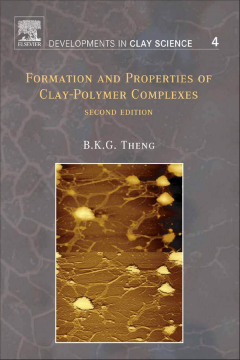
Additional Information
Book Details
Abstract
Formation and Properties of Clay-Polymer Complexes provides a comprehensive account of the reactions between clay minerals and organic polymers. The book opens with a discussion of the structures of common clay minerals, clays colloid chemistry, and the behaviour of organic polymers at clay surfaces. This is followed by a systematic treatment of complex formation between clay minerals and various classes of synthetic and naturally occurring polymers, a description of the properties of the resulting complexes and, wherever appropriate, their practical applications. The book will have a new separate chapter on clay-polymer nanocomposites. Each chapter is written as a self-contained review paper, giving a list of reference to the original literature.
- Describes the important development in clay-polymer nanocomposites
- Contains new figures and diagrams
- Extenisve revision of the previous edition
" Theng has made a remarkable effort to combine a voluminous source of information that exists on the interaction of clays with organic polymers and should be congratulated for this effort. The book was long awaited and indeed will be an important reference like the first edition…The overall result is definitely positive and the book should be in the shelf of any mineralogist, soil scientist, chemist and biologist who is interested in these interactions." --Clay Minerals, 2014
"Theng reviews and synthesizes the literature on clay minerals and polymer adsorption, and interactions of clay minerals with synthetic and naturally occurring polymers. His topics include polymer behavior at clay and solid surfaces, uncharged (nonionic) polymers, positively charged polymers (polycations), some practical application of the clay-polymer interaction, polymer-clay nanocomposites, proteins and enzymes, viruses and bacteriophages, and humic substances. He has updated the 1979 first edition to incorporate the substantial developments in clay science that partly result from the application of modern surface analytical, computational, and spectroscopic techniques. He has also added many new illustrations and tabulated data." --Reference and Research Book News, October 2012
